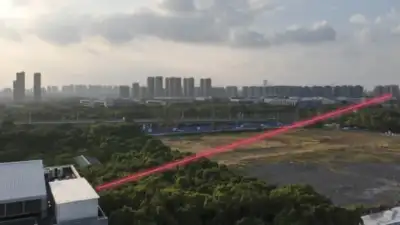China builds laser that can read text smaller than a grain of rice from a mile away | – The Times of India

In a breakthrough that blurs the line between science fiction and reality, Chinese scientists have unveiled a powerful laser-based imaging system capable of reading text as small as one millimetre, smaller than a grain of rice, from nearly 1.4 kilometres (about a mile) away. Using a technique called active intensity interferometry, the system overcomes common challenges like atmospheric distortion and poor resolution over long distances. This innovation could reshape fields ranging from archaeology to wildlife monitoring and security. However, the technology also raises new concerns around privacy, surveillance, and ethical use.
How the ‘spy’ laser works to read text from a mile away
Traditional telescopes and long-range lenses often struggle to detect fine details over long distances due to atmospheric interference and diffraction limits. The Chinese research team bypassed these issues by focusing not on capturing an image directly but on analysing the way light interacts with surfaces. Their approach, called active intensity interferometry, uses laser beams and measures the light pattern that bounces back from a target. This allows them to reconstruct high-resolution images of extremely small features.
Why this is a major leap in resolution
The laser system achieved a 14-fold improvement in resolution compared to what a single telescope could capture at the same distance. While standard systems at a mile’s range can only make out objects around 42 millimetres in size, this new laser can accurately resolve millimetre-scale text. That level of precision means it can read markings, labels, or carvings that were previously invisible from such distances.
Limitations and challenges
Despite its impressive capabilities, the system comes with several limitations. For the laser to function effectively, it needs a clear line of sight to the target and cannot operate in complete stealth mode, as the target must be actively illuminated with laser light. This makes it unsuitable for certain surveillance or military operations that require secrecy. Moreover, atmospheric conditions such as dust or fog could impact performance.
Potential applications beyond surveillance
While some may worry about the system being used for spying, the researchers suggest more constructive applications. Archaeologists could use the laser to read ancient inscriptions on cliffs without scaling dangerous heights. Environmental scientists might observe hard-to-reach habitats without disturbing the ecosystem. Infrastructure inspectors could scan for micro-cracks or surface markings on remote structures.
What’s next for the technology
The research team plans to improve the system’s ease of use by developing more precise laser controls. They are also working on integrating artificial intelligence into the reconstruction process, which could allow for faster, more accurate image rendering in real-time. If successful, this technology could become a standard tool for high-resolution imaging across multiple disciplines.
















